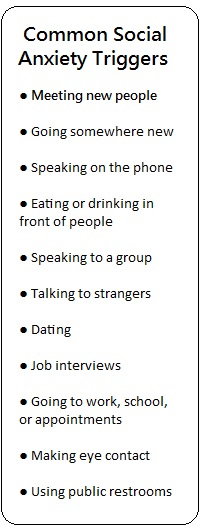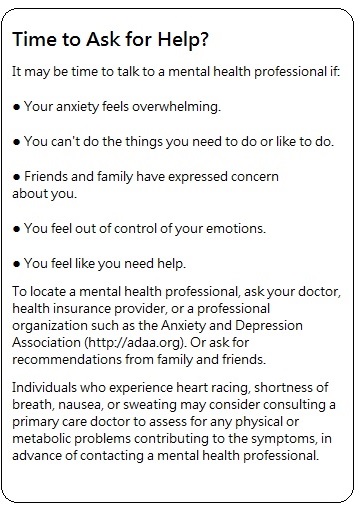Eyes on Me: Dystonia & Social Anxiety
This article appeared in the Dystonia Dialogue.

Moments of social awkwardness are a common human experience. We may feel anxious or uncomfortable when meeting new people, public speaking, or in other situations where we are the focus of attention. For some of us, the anxiety becomes severe and permeates social interactions of any and all kinds.
“Some people have social anxiety disorder, or social phobia, which is an intense fear of being judged or negatively evaluated in social situations,” explains Bryan Bernard, PhD, a neuropsychologist with expertise in movement disorders at Rush University Medical Center. “The individual is concerned that they will say or do something that will result in embarrassment or humiliation.” This fear can affect work, school, relationships, and daily life. “People with social anxiety disorder tend to avoid social situations, and when the situation cannot be avoided, they experience significant physiological symptoms of anxiety such as increased heart rate, nausea, or hyperventilation.”
Estimates suggest 7% of the general population have social anxiety disorder. For individuals with dystonia, the percentage may be as much as 10 times higher.
“Of the non-motor symptoms that we see in dystonia,” says movement disorder specialist Brian Berman, MD, MS of University of Colorado Movement Disorder Center, “the psychiatric disorders are of specific interest because of how common they are and because of how often they can be disabling, even more disabling than the motor symptoms, and have a greater impact on quality of life.”
Untangling Dystonia & Anxiety
Researchers are working to understand the complex relationship between dystonia and anxiety.
“Some studies support the premise that the dystonia leads to increased anxiety and social anxiety, but then there are equally other studies that provide evidence that these disorders can occur before someone has the motor symptoms of the dystonia, suggesting that it’s part of a clinical spectrum rather than just a reaction to the motor symptoms,” explains Dr. Berman.
Social anxiety often begins in childhood or adolescence. Social anxiety disorder is sometimes confused with shyness, which is a tendency to feel awkward or tense during social encounters but does not necessarily include the fear of scrutiny or embarrassment that is a hallmark of social anxiety disorder.
Donna Russow, LCSW, ACSW is a Certified Life Coach and Licensed Therapist. She was diagnosed with cervical dystonia in 2009. “A lot of people with dystonia do have a physical difference and that itself can make you feel embarrassed or make you wonder what somebody’s going to think about you,” she explains.
The physical symptoms of dystonia can alter posture, body language, facial expressions, eye contact, and voice quality—all of which are at play when interacting with other people. Furthermore, dystonia symptoms are known to worsen in social situations and can be exacerbated by stress, which heighten the physical and emotional discomfort of social interactions.
Ms. Russow elaborates: “The other thing is, when we have dystonia, you might be home alone a lot, you’re unable to work or do a lot of the things you used to do that could provide the normal social interaction most people take for granted. So the isolation is greatly increased. And, because people do feel different, they begin intentionally to avoid situations where they may feel embarrassed or humiliated because of the disorder.”
 Who is Most at Risk?
Who is Most at Risk?
It might be natural to assume that individuals with the most severe dystonia symptoms are more prone to social anxiety, but this does not necessarily seem to be the case. “Patients with dystonia and social anxiety disorder may have feelings of low self-esteem and disturbed body image,” explains Dr. Bernard.
In a study comparing rates of social anxiety among adults with cervical dystonia, essential tremor, and hemifacial spasm, the frequency of social anxiety disorder and impact on quality of life were similar across these disorders. The patients who experienced the most severe social anxiety tended to be younger and had co-occurring depression. The severity of social anxiety correlated to the patient’s perception of physical disfigurement and negative body image. It was not the individuals who had the most severe movement symptoms, or who had lived with a movement disorder the longest, who were prone to social anxiety disorder. Individuals who were depressed and self-critical about the physical appearance of the motor symptoms had the most severe social anxiety.
Similarly, in a large study of cervical dystonia patients, a high prevalence of social anxiety disorder was associated with depression rooted in negative body image. The prevalence of social anxiety disorder was more than 50%, and in most cases (80%) the individuals reported that onset followed the cervical dystonia.
Dr. Berman led a large international study of adults with focal dystonia which revealed that high levels of depression, anxiety, and social anxiety occurred across all types of focal dystonia. However the severity of anxiety and social anxiety varied by the type of dystonia and body parts affected. “We found that 45% overall of the adult onset focal dystonia patients—those with blepharospasm, cervical dystonia, cranial dystonia, laryngeal dystonia, limb dystonia–had clinically significant social anxiety, but then we also found that the rates vary quite a bit. It ranged from 32% in those with limb dystonia up to 73% of those with laryngeal dystonia, so there may be a wide variation in social anxiety symptoms amongst those with different focal expressions of dystonia.”
Dr. Berman and his team found that, “At least in laryngeal dystonia, there was a strong link between the motor symptoms and the severity of social anxiety, but in the other forms of dystonia it was less evident that there was that relationship.” The study did not conclude why higher rates of social anxiety were seen in individuals with laryngeal dystonia but suggested it could be related to the unique role speaking plays in social interaction. Laryngeal dystonia, also referred to as spasmodic dysphonia, is a focal dystonia that affects the voice box and impairs speech.
 Seeking Help
Seeking Help
Social anxiety becomes a problem when it happens frequently, intensely, and to the extent that individuals have difficulty functioning in their lives. Relationships may be strained. “Anxiety can affect quality of life by limiting social interactions, which are generally positive, and thereby limit the potential emotional support we can receive from other people,” explains Dr. Bernard. Job performance or career trajectory may be suffering. “Social anxiety can lead people to avoid possible promotions at work or going on job interviews or turning down opportunities they know otherwise could benefit them,” says Ms. Russow.
Social anxiety generally does not go away without treatment. Evaluating for and addressing anxiety is an essential part of a comprehensive dystonia treatment plan. “Even if you find that you’re making progress on the motor symptoms, there could be persistent psychiatric disorders that are impairing quality of life,” explains Dr. Berman.
There is a growing wealth of evidence that social connection is vital to good physical and mental health. “We are healed through social connection,” says Ms. Russow. “In healthy social interactions, we learn to trust, we discover parts of ourselves that we didn’t know about. When we’re not able to be in social connection, or we choose not to be, because of social anxiety, it can be damaging. But the good news is there is hope and ways to deal with that.”
Cognitive behavioral therapy (CBT) provided by a certified professional is typically the most effective type of psychotherapy for social anxiety disorder. CBT may be used in combination with oral medications, depending on the needs of the individual. Relaxation techniques, such as meditation and deep-breathing exercises, can reduce the physiological symptoms of anxiety. In most cases, treatment can dramatically reduce or eliminate social anxiety disorder symptoms, and the benefits are long lasting.
Breaking through Isolation
Social connection is not always about venturing outward. “On my really bad days,” says Ms. Russow, “when my friends would call and say, How are you doing? Can we bring you some soup? My first thought would be no, I just want to be alone. But then I would say, no, I don’t want to isolate. So, they would come over and it was a great distraction. By the time they left, I felt not just mentally but physically better. It’s not all about going out. It’s also about inviting people in.”
“The clinical spectrum of dystonia is expanding,” explains Dr. Berman, “and these psychiatric symptoms as well as pain and other non-motor symptoms may be linked. I want to encourage patients to not feel shame and to feel free to bring these symptoms up with their movement disorder specialist or other medical practitioners and seek help because the benefit can be drastic. We know that if we if we can improve the psychiatric disorders that we improve quality of life.”
“The dystonia doesn’t have to define you,” says Ms. Russow, “you can break through the isolation.”
The Dystonia Medical Research Foundation is a 501(c)(3) non-profit organization dedicated to advancing research for improved dystonia treatments and ultimately a cure, promoting awareness, and supporting the well-being of affected individuals and families.




One Response